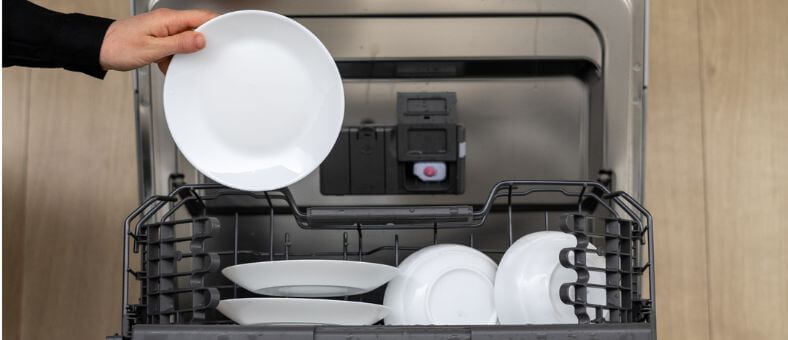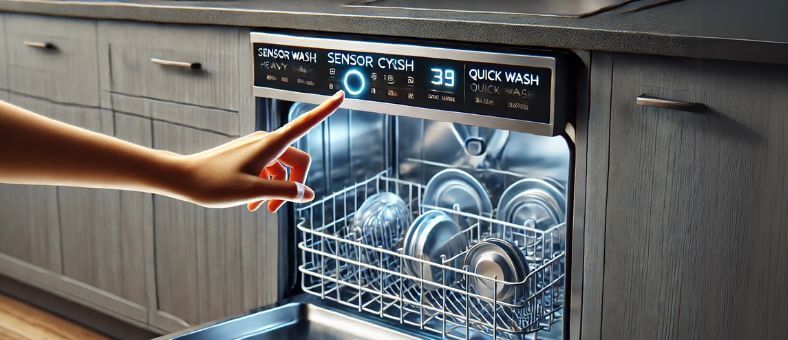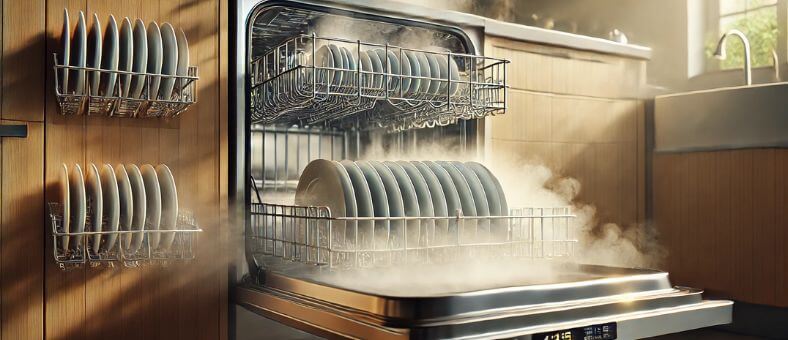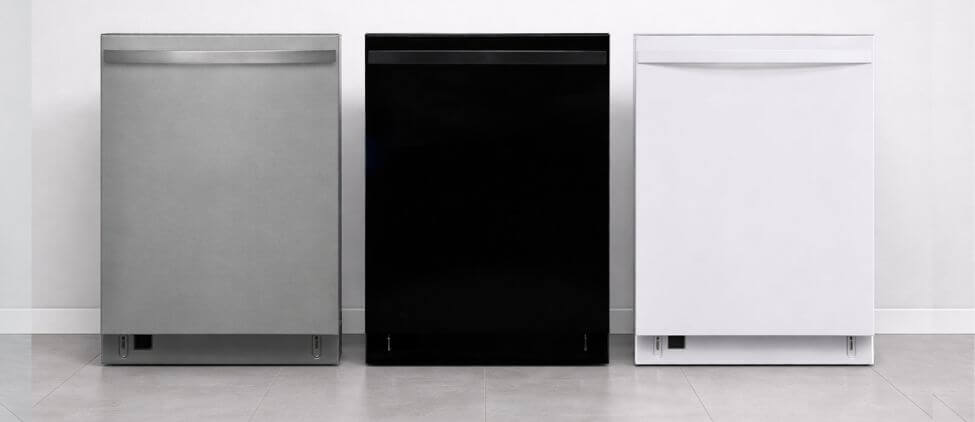Knowing your Dishwasher Cycles and Settings is key to sparkling clean dishes. It goes beyond simply loading the dishwasher and hitting the start button. The cycle you choose dramatically affects how clean your dishes get, how much water and energy is used, and even how long it takes for the process to complete. Let’s explore the standard Dishwasher Cycles and Settings, what they do, and when to use them.
Table of Contents
Dishwasher Cleaning Modes
There’s a variety of cleaning modes available on most modern dishwashers. These settings offer different wash and rinse combinations to best clean your dishes based on how dirty they are and what items are being cleaned.

Sensor Wash
The sensor wash, also known as auto or smart wash, uses sensors inside the dishwasher to determine how dirty the dishes are. The dishwasher then adjusts the cycle length, temperature, and water usage based on the level of dirt detected. This setting is perfect for mixed loads with varying degrees of dirtiness, ensuring efficient energy and water use.
Heavy Cycle
As the name suggests, the heavy cycle is designed for the most challenging jobs. This cycle utilizes more water and higher temperatures when cleaning heavily soiled items such as pots, pans, and casserole dishes. It’s a longer cycle, but it ensures thorough cleaning of food particles that are more challenging to remove.
Intensive Wash Mode
This mode is designed for heavily soiled dishes or left dirty for an extended period. Using hotter water and a longer wash duration, the Intensive Wash Mode ensures deep cleaning for stubborn stains and residues.
Normal Cycle
The normal cycle is suitable for everyday dish loads with typical food soil. This cycle balances cleaning power and energy efficiency, making it ideal for regular use. It thoroughly cleans your dishes without the heavy cycle’s higher energy and water usage. Typically, the standard setting uses a temperature of around 120°F to 140°F, suitable for regular dish loads.
1-Hour Cycle
The 1-hour cycle, or express or quick wash, is your go-to when you need clean dishes fast. This cycle uses higher water pressure to clean lightly soiled dishes quickly. It’s perfect for glasses, lightly soiled plates, and bowls, but it might only partially clean heavily soiled items. It’s a great option when you’re entertaining and need a quick turnaround of dishes.
Pre-wash Cycle
The pre-wash cycle, as the name suggests, is a short wash intended to rinse off food residues before the main wash cycle. It’s useful when you have dishes with dried-on or stubborn food particles. It helps to loosen and remove this residue, preparing the dishes for the main wash.
Hi-Temp Cycle
The high-temperature (Hi-Temp) cycle uses hotter water than standard cycles. This is particularly effective for heavily soiled items or for dishes with greasy residues. The heat helps to break down these residues more effectively, leading to a thorough cleaning. However, it is essential to note that this cycle uses more energy and may not be suitable for delicate items that could be damaged by high temperatures.
Automatic Cycle
The automatic cycle leverages the dishwasher’s technology to gauge the soil level on the dishes. Depending on this assessment, it adjusts the cycle’s intensity and duration. This feature is designed for those who want a more hands-off approach to dishwashing, allowing the machine to decide the best cleaning mode.
Sanitize Cycle
The sanitizing cycle heats water to a higher temperature, effectively killing 99.9% of bacteria, according to NSF/ANSI Standard 184. It’s a good choice when you want to disinfect your dishes, cutting boards, or baby bottles. The sanitizing setting goes even higher, often reaching up to 150°F or more, to ensure the elimination of bacteria and germs. However, remember this cycle might take a little longer due to the higher temperature level required for sanitation.
Quick Wash Cycle
If you’re in a hurry, the quick wash cycle is your friend. The purpose of this cycle is to quickly clean dishes and glassware that are only lightly soiled in a shorter amount of time than the normal cycle. While it’s not the best option for heavily dirty dishes, it’s perfect when quickly cleaning a load of dishes used for serving or drinks. Please be aware that results might vary based on your dishwasher model and the level of soiling on your
Half-load Option
Modern dishwashers offer a half-load option for households that may not frequently amass a full load of dishes but don’t want them piling up. This setting is designed for washing smaller loads without wasting water and energy that would be used for a full load. While the exact operation might vary depending on the dishwasher brand and model, the half-load option generally shortens the cycle or uses less water, ensuring efficiency when washing fewer dishes. It’s an excellent choice for those looking to save on resources when they don’t have a full dishwasher load.
For a quick visual breakdown of dishwasher cleaning modes and how they work, check out this helpful video:
Dishwasher Drying Options
Once your dishwasher has cleaned your dishes, it’s time for them to dry. There are a few different drying options available in modern dishwashers. Each has its benefits and is suitable for other circumstances.

Heat Dry Method
Heat dry is a commonly used method in many dishwashers. In this process, the dishwasher uses an electric heating element at the bottom to heat the air inside and help the dishes dry faster through evaporation. This method can effectively dry dishes but uses more energy than other methods. If you choose this option, it’s best to open the dishwasher door after the cycle has ended to let the hot air and humidity escape.
Extended Drying
Extended drying is an option that, when selected, adds more time to the drying phase of the cycle. The heat generated during the final rinse is used, and the duration is extended, allowing more time for the dishes to dry naturally within the heat retained inside. This option may be helpful for loads with many plastic items, as plastic tends not to dry, as well as glass or ceramic.
Power Dry: Short vs. Long
Power drying is a feature found in some dishwashers that uses an active venting system to remove humid air from the dishwasher, replacing it with dry air from outside. This method can considerably reduce drying times. The short power dry is ideal for less full loads or less dense items, while the long power dry is suitable for full loads or denser items. Please remember that power-dry options use more energy than other drying methods.
Advantages of Modern Dishwasher Settings
- Customizable Wash Cycles: Modern dishwashers offer adjustable settings to cater to different dishwashing needs.
- Flexibility for Various Loads: Users can optimize cleaning efficiency based on load size, soil level, and dishware type.
- Ideal for Different Dishware: Settings accommodate everything from delicate wine glasses to heavily soiled pots and pans.
- Energy and Water Conservation: Specialized cycles help reduce energy and water usage when full-power cleaning isn’t necessary.
- Prolongs Dishware Longevity: Prevents damage by allowing users to choose appropriate settings for fragile or durable items.
- Optimized Cleaning Performance: Hard and soft water settings improve washing effectiveness based on regional water conditions.
- Convenience and Efficiency: Customizable settings perfectly balance ease of use and effective cleaning.
Effective Ways to Reduce Dishwasher Cycle Duration
Cutting down on dishwasher cycle time saves energy and speeds up kitchen cleanup. Here are some practical steps to ensure your dishwasher runs efficiently without unnecessary delays.
1. Optimize Dish Loading for Faster Cleaning
- Avoid overcrowding dishes, as overlapping items can block water jets, leading to longer cycles.
- Place larger and heavily soiled items in the lower rack where spray arms reach more effectively.
- Angle dishes properly to allow water and detergent to circulate efficiently.
2. Select the Most Efficient Cycle
- Use quick wash or light wash for lightly soiled dishes to cut cycle time.
- Skip heavy-duty cycles unless dealing with stubborn, baked-on food.
- If your dishwasher has an express mode, activate it for a faster clean without compromising performance.
3. Use the Time Delay Feature for Smart Scheduling
- Although it won’t shorten the cycle, delayed start allows you to run the dishwasher during off-peak hours, reducing electricity costs.
- Set the delay so dishes finish just before you need them, optimizing your routine. To learn more about maximizing this feature for energy savings and convenience, check out our guide on How to Use the Delay Start Option.
Steps to Maximize Dishwasher Efficiency
Enhancing your dishwasher’s efficiency doesn’t just mean cleaner dishes; it also helps save water, energy, and detergent while extending the appliance’s lifespan. Follow these key steps to get the best performance from your dishwasher.
1. Scrape Instead of Pre-Rinsing
- Why? Modern dishwashers are built to handle food residues, so excessive pre-rinsing wastes water and energy.
- Best Practice: Scrape off large food particles and load dishes directly into the dishwasher.
2. Load Smartly for Maximum Cleaning Power
Proper loading ensures your dishwasher operates efficiently and delivers spotless results. How to Load Your Dishwasher Properly provides a step-by-step guide to arranging your dishes for optimal cleaning.
- Place heavily soiled items on the bottom rack, facing spray arms, for a deep clean.
- Position cups, glasses, and plastic items on the top rack to prevent warping from heat.
- Ensure utensils are evenly spaced to prevent nesting and ensure thorough washing.
3. Run Full Loads for Maximum Efficiency
- Why? Running half-empty cycles wastes water and electricity.
- Pro Tip: If you must run a smaller load, use an eco-friendly or half-load setting to reduce water consumption.
4. Perform Routine Maintenance
- Clean the filter every few weeks to prevent food buildup.
- Wipe down door seals to prevent mold and leaks.
- Unclog spray arms to ensure even water distribution.
5. Use High-Performance Detergent
- Why? High-efficiency detergents work better in modern dishwashers, especially in lower-temperature washes.
- Tip: Avoid excessive detergent use—it can leave behind residue and reduce rinse effectiveness.
For the best cleaning performance, check out our guide on 6 Best Dishwasher Detergents to find the right one for your needs.
6. Add a Rinse Aid for Spotless Results
- Benefit: Rinse aids speed up drying, prevent water spots, and improve overall cleaning performance.
- Usage: Adjust the rinse aid dispenser settings based on your water hardness for optimal results.
Discover the 6 Best Dishwasher Rinse Aids to enhance drying and achieve a streak-free shine on your dishes.
Understanding Dishwasher Cycle Duration

The length of a dishwasher cycle varies depending on multiple factors, including the selected wash setting, the level of food residue on dishes, and the appliance’s efficiency. Light or express cycles, designed for dishes with minimal grime, can finish in as little as 20 minutes to an hour. On the other hand, standard or heavy-duty cycles, which provide deeper cleaning for heavily soiled dishes, may last anywhere from 1.5 to 4 hours.
Additional features like heated drying and sanitization settings can extend the overall duration by increasing water temperature and drying time. However, many modern dishwashers now include quick wash options, allowing users to speed up cleaning without compromising performance, which is perfect for lightly soiled items when time is a priority.
Understanding Dishwasher Hard Water and Soft Water Settings
Dishwasher settings can vary depending on the type of water available in your area. Hard water contains higher mineral content, primarily calcium and magnesium, which can leave residue on dishes and affect detergent performance. Soft water, on the other hand, has fewer minerals, allowing detergents to work more effectively. Adjusting dishwasher settings based on water type ensures optimal cleaning performance and prevents long-term appliance damage.
| Hard Water Settings | Soft Water Settings |
|---|---|
| Use more detergent to counteract mineral buildup. | Use less detergent to prevent excess suds. |
| Increase rinse aid usage to reduce water spots. | Minimal rinse aid is needed for optimal drying. |
| Select longer wash cycles to ensure thorough cleaning. | Shorter cycles are effective due to better detergent performance. |
| Use high-temperature wash settings to dissolve mineral deposits. | Standard temperature settings are sufficient. |
| Regularly clean dishwasher with descaling solutions. | Periodic cleaning with vinegar or a mild detergent is sufficient. |
| Install a water softener or use dishwasher salt to prevent limescale. | No additional softening agents are required. |
The Bottom Line on Dishwasher Cycles and Settings
Understanding your dishwasher’s cycles and settings is essential for effective operation, longer appliance lifespan, and energy savings. The different cycles offer the flexibility to handle various dish loads and soil levels. The proper settings can also contribute to achieving sparkling clean dishes. Whether you’re looking to save time, enhance cleaning performance, or improve energy efficiency, this guide provides insights to help you make the most of your dishwasher. Ultimately, the goal is to help you save time and energy while achieving the best possible cleaning results.
Frequently Asked Questions (FAQs)
How does the silent mode in dishwashers work?
Silent mode utilizes optimized motors and sound insulation to minimize noise, offering a quieter wash experience.
What is a dishwasher’s quiet decibel (dB) level?
A dishwasher with a rating of 40-45 dB is considered quiet. If it falls below 40 dB, it is considered exceptionally quiet.
What are the different detergent dispenser options available?
Dishwashers often come with single, dual, or automatic dispensers. They can dispense powder, liquid, or tablet detergents.
Are built-in detergent dispensers better than manual additions?
Built-in dispensers offer precise detergent release, optimizing cleaning efficiency and reducing waste.
What does a standard wash cycle typically involve?
It involves a pre-wash, main wash, and rinse, efficiently cleaning everyday soiled dishes.
How long does a standard wash cycle usually last?
Most standard cycles last 1 to 2 hours, varying based on the model and soil level.
Why are new dishwasher cycles longer than older models?
Newer models prioritize energy and water efficiency. Longer cycles often achieve cleaner dishes using fewer resources.
Does a longer cycle mean more electricity consumption?
Not necessarily. Due to efficient designs, new models may run longer but often use less energy per cycle.
How much water does a typical dishwasher use per cycle?
On average, modern, efficient dishwashers use 3-5 gallons per cycle, while older models might use up to 15 gallons.
More Articles
Keeping Your Dishwasher in Top Shape
Keeping your dishwasher clean and running smoothly is key to maintaining its performance and extending its lifespan. Here are some helpful reads from our site to ensure your appliance stays in top condition for years to come:
- Is Pre-Rinsing Necessary? Dishwasher Myths Busted
- The Dishwasher’s Impact on Knives: What You Need to Know
- Why Does the Sink Fill Up When Running the Dishwasher?
- How Much Water Do Dishwashers Use?
- How to Clean Dishwasher Spray Arms?
Explore More Articles to Improve Your Dishwashing Skills
- Stainless Steel vs. Plastic Tub Dishwashers: Which is Better?
- First Time Using a Dishwasher? The Ultimate Beginner’s Guide!
- Dishwasher Myths: 7 Shocking Truths You Must Know!
- How to Dispose of and Recycle a Dishwasher?
- Heat Dry vs. Air Dry
WashDryDazzle is committed to delivering valuable insights and meticulously compiled lists, ensuring you discover the best products to meet your requirements. We also provide extensive dishwasher guides and expert education to help you maintain proper appliance care and management.










